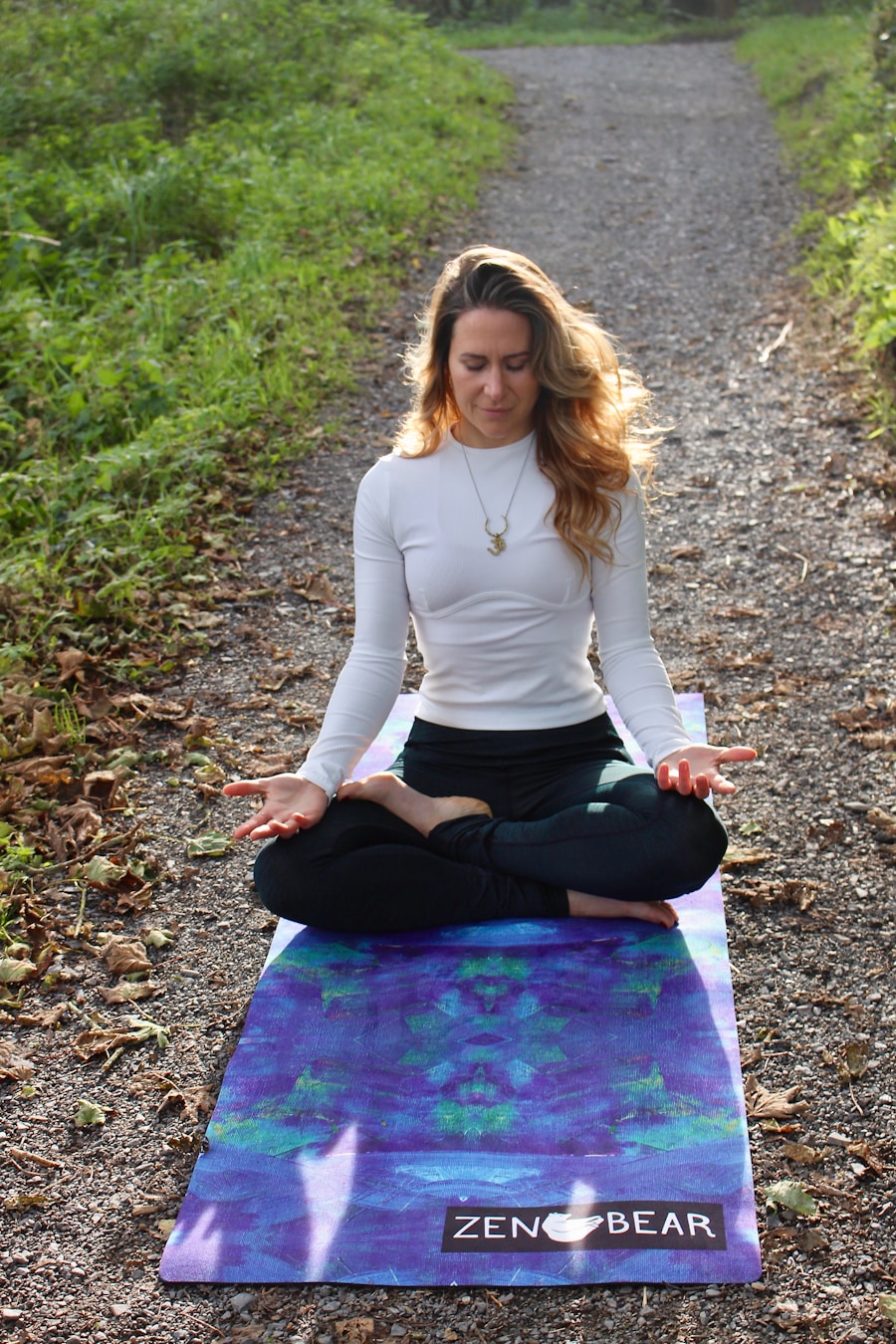The relationship between yoga and stress is deeply rooted in the practice’s historical and philosophical foundations. Yoga, originating from ancient India, is not merely a physical exercise but a holistic approach to well-being that encompasses the mind, body, and spirit. Stress, on the other hand, is a modern affliction that manifests in various forms, including anxiety, tension, and emotional turmoil.
The connection between these two elements lies in yoga’s ability to foster a state of balance and tranquility amidst the chaos of daily life. By engaging in yoga, individuals can cultivate a greater awareness of their physical sensations and emotional states, allowing them to respond to stressors with a sense of calm rather than reactivity. The physiological effects of stress are well-documented; when faced with stressors, the body enters a state of fight-or-flight, releasing hormones such as cortisol and adrenaline.
Yoga serves as a counterbalance to this response by promoting relaxation and reducing the levels of stress hormones in the body. Through mindful movement and breath control, practitioners can activate the parasympathetic nervous system, which is responsible for the body’s rest-and-digest functions.
This activation not only alleviates immediate feelings of stress but also contributes to long-term resilience against future stressors.
Key Takeaways
- Yoga can help reduce stress by calming the mind and relaxing the body through a combination of physical postures, breathing techniques, mindfulness, and meditation.
- The benefits of yoga for stress management include improved flexibility, reduced muscle tension, lower blood pressure, and increased feelings of relaxation and well-being.
- Incorporating breathing techniques in yoga, such as deep belly breathing and alternate nostril breathing, can help reduce stress and promote a sense of calm and balance.
- Practicing mindfulness and meditation in yoga can help reduce stress by increasing self-awareness, promoting a sense of inner peace, and improving the ability to cope with stressors.
- Choosing the right yoga poses for stress relief, such as child’s pose, forward fold, and corpse pose, can help release tension and promote relaxation in the body and mind.
- Creating a regular yoga routine for managing stress can help establish a sense of routine and consistency, providing a dedicated time for self-care and stress relief.
The Benefits of Yoga for Stress Management
Yoga offers a multitude of benefits specifically tailored for stress management. One of the most significant advantages is its ability to enhance emotional regulation. Regular practice encourages individuals to observe their thoughts and feelings without judgment, fostering a sense of detachment from negative emotions.
This practice of non-attachment can lead to improved emotional resilience, allowing individuals to navigate life’s challenges with greater ease. For instance, someone who regularly practices yoga may find themselves less reactive in stressful situations, responding with clarity rather than frustration. Moreover, yoga promotes physical well-being, which is intrinsically linked to mental health.
The various postures (asanas) practiced in yoga help release physical tension stored in the body. For example, poses such as Child’s Pose or Forward Bend can alleviate tightness in the shoulders and neck—common areas where stress manifests physically. Additionally, yoga enhances flexibility and strength, contributing to an overall sense of vitality that can combat feelings of lethargy often associated with stress.
The combination of physical release and increased energy levels creates a powerful antidote to the fatigue that often accompanies chronic stress.
Incorporating Breathing Techniques in Yoga for Stress Relief

Breath control, or pranayama, is a fundamental aspect of yoga that plays a crucial role in stress relief. The breath serves as a bridge between the mind and body; by consciously regulating it, practitioners can influence their physiological state and emotional well-being. Techniques such as deep abdominal breathing or alternate nostril breathing can significantly reduce anxiety levels and promote relaxation.
For instance, deep breathing activates the diaphragm, allowing for fuller oxygen exchange and stimulating the vagus nerve, which helps lower heart rate and blood pressure. Incorporating these breathing techniques into a yoga practice can transform how one experiences stress. For example, during a particularly challenging pose or sequence, focusing on the breath can provide an anchor point that helps maintain composure.
This practice not only enhances physical performance but also cultivates a sense of mindfulness that can be carried off the mat into daily life. When faced with stressful situations outside of yoga practice, individuals who have developed strong pranayama skills may find it easier to return to a state of calm by simply focusing on their breath.
Practicing Mindfulness and Meditation in Yoga to Reduce Stress
Mindfulness and meditation are integral components of yoga that contribute significantly to stress reduction. Mindfulness involves being fully present in the moment without judgment, allowing individuals to observe their thoughts and feelings as they arise. This practice encourages a deeper understanding of one’s internal landscape, enabling practitioners to identify stress triggers and respond more effectively.
For example, during a yoga session, one might notice feelings of frustration or anxiety arising during challenging poses. By practicing mindfulness, they can acknowledge these feelings without becoming overwhelmed by them. Meditation complements this practice by providing a structured way to cultivate inner peace and clarity.
Many yoga classes incorporate meditation techniques that guide practitioners into a state of deep relaxation and focus. Techniques such as guided imagery or mantra repetition can help quiet the mind and reduce racing thoughts that often accompany stress. Research has shown that regular meditation practice can lead to structural changes in the brain associated with improved emotional regulation and decreased anxiety levels.
By integrating mindfulness and meditation into their yoga routine, individuals can develop a more profound sense of self-awareness and emotional stability.
Choosing the Right Yoga Poses for Stress Relief
Selecting appropriate yoga poses is essential for maximizing stress relief benefits. Certain postures are particularly effective at promoting relaxation and releasing tension held in the body. Restorative poses such as Legs-Up-the-Wall (Viparita Karani) or Supported Bridge Pose (Setu Bandhasana) encourage deep relaxation by allowing gravity to assist in releasing tight muscles while promoting blood flow back to the heart.
These poses are often held for extended periods, providing ample time for practitioners to connect with their breath and cultivate a sense of calm. Additionally, gentle forward bends like Seated Forward Bend (Paschimottanasana) or Child’s Pose (Balasana) are excellent choices for stress relief as they promote introspection and grounding. These poses encourage surrendering to gravity while simultaneously stretching the spine and calming the nervous system.
Incorporating gentle twists such as Supine Spinal Twist (Supta Matsyendrasana) can also aid in releasing tension from the back while stimulating digestion and detoxification processes—further contributing to overall well-being. By thoughtfully selecting poses that resonate with their needs, practitioners can create a personalized practice that effectively addresses their unique stressors.
Creating a Regular Yoga Routine for Managing Stress

Establishing a consistent yoga routine is vital for effectively managing stress over time. A regular practice allows individuals to build resilience against stressors while fostering a deeper connection with themselves. To create an effective routine, it is essential to consider personal preferences regarding style, duration, and frequency of practice.
For instance, someone who enjoys dynamic movement may opt for Vinyasa or Ashtanga styles, while those seeking tranquility might prefer Yin or Restorative yoga. Setting aside dedicated time for yoga practice—whether it’s 15 minutes each morning or an hour several times a week—can help reinforce the habit and make it an integral part of one’s lifestyle. Additionally, incorporating variety into the routine can keep it engaging; alternating between different styles or focusing on specific themes such as breathwork or mindfulness can enhance motivation and deepen one’s practice.
Utilizing resources such as online classes or local studios can provide guidance and inspiration for maintaining consistency.
By embracing its physical postures, breathing techniques, mindfulness practices, and creating a regular routine tailored to individual needs, practitioners can cultivate resilience against stress while enhancing their overall well-being.
If you are interested in delving deeper into the world of logic and reasoning, you may want to check out the article Understanding Variables in Propositional and Predicate Logic. This article explores the intricacies of variables in logic, which can help sharpen your analytical skills and enhance your problem-solving abilities. Just as yoga practices can help manage stress and promote overall well-being, understanding logic can also contribute to mental clarity and cognitive agility.
FAQs
What is stress?
Stress is the body’s natural response to any kind of demand or threat. It can be caused by both positive and negative situations and can manifest in physical, emotional, or mental symptoms.
What is yoga?
Yoga is a mind and body practice that combines physical postures, breathing exercises, and meditation. It aims to promote relaxation, reduce stress, and enhance overall well-being.
How can yoga help manage stress?
Yoga can help manage stress by promoting relaxation, reducing muscle tension, and calming the mind through breathing techniques and meditation. It also encourages mindfulness and self-awareness, which can help individuals better cope with stressors.
What are some yoga practices for managing stress?
Some yoga practices for managing stress include gentle yoga poses, deep breathing exercises, meditation, and relaxation techniques such as yoga nidra. These practices can help release tension, calm the mind, and promote a sense of inner peace.
Is yoga suitable for everyone to manage stress?
Yoga can be beneficial for most people in managing stress, but it’s important to consult with a healthcare professional before starting any new exercise or stress management program, especially for individuals with certain medical conditions or physical limitations.
How often should one practice yoga to manage stress effectively?
The frequency of yoga practice for managing stress can vary for each individual. Some people may benefit from daily practice, while others may find relief from stress with just a few sessions per week. It’s important to find a routine that works best for each person’s unique needs and schedule.






















+ There are no comments
Add yours